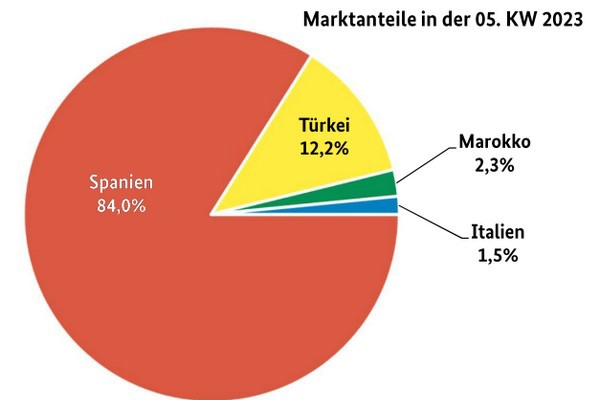Spanish sweet peppers had a firm grip on the market but were unable to meet the demand to the full extent. Turkish imports followed in importance, but they were completely absent in Cologne. Italian lots were available exclusively in Frankfurt, where they were briskly sold -red and yellow- at €12 per 3 kg carton. There, as well as in Berlin, there were also red California from Morocco. According to the BLE, availability had been limited, in particular by the very low temperatures in all growing regions.

In addition to the delayed color change in red and yellow pods, there was also a shortage of the tricolor mixes reserved for the trade. Yellow produce became significantly more expensive, as its presence was apparently limited. In Munich, this also led to rising prices for mixed goods. In Frankfurt, prices rose to as much as €28 per 5-kg carton for yellow items and to €19 for red items.
Apples
Domestic Elstar, Jonagold, Tenroy, and Breaburn formed the basis of the range. From Italy, Golden Delicious, Granny Smith, and Royal Gala were the main varieties.
Pears
Italian shipments were dominated by Abate Fetel, Santa Maria, and Williams Christ. In terms of relevance, Turkish Santa Maria and Dutch Conference followed.
Table grapes
The supply was mainly composed of inflows from Namibia, South Africa and Peru. Goods from Brazil and Ecuador completed the scene.
Oranges
Spanish fruits continued to dominate among the blond oranges. Navelina was the main fruit, but in some cases, it had already been replaced by Lane Late and Navelate. This change in range led to a shortage of availability in Munich, which resulted in higher prices.
Small citrus fruits
Spanish mandarins were obviously predominant: Tango, Clemenvilla, and Nadorcott were in priority supply. From Morocco came mainly Nadorcott, and from Turkey, mostly Murcott.
Lemons
Spanish deliveries dominated over Turkish ones. Italian untreated products appeared only sporadically.
Bananas
Business was fairly quiet everywhere. In some places, supplies were rather tight. Although demand was met, prices nevertheless trended upwards in these cases.
Cauliflower
Prices rose steeply: In Frankfurt, customers were expected to pay up to €26 for French lots in 6-packs as early as Monday, and prices continued to rise successively over the rest of the week. Prices were similarly high in the other markets.
Lettuce
The picture was the same for almost all lettuce varieties: shipments had become more limited, and prices rose. Frost and bad weather limited deliveries of Spanish iceberg lettuce.
Cucumbers
Overall, business was fairly quiet. Spanish snake cucumbers predominated. They were flanked primarily by Greek produce and secondarily by Belgian, Dutch, and Moroccan.
Tomatoes
Panicle produce came primarily from Spain, Turkey, and Italy. Round tomatoes were supplied mainly from Morocco and Spain.
Source: BLE
